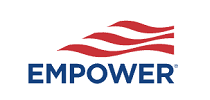(Personal Capital is now Empower)
Wealth managers like Betterment, Wealthfront, and Empower help you invest your money without as much human interaction as you’d have with a traditional financial advisor.
I personally like this concept of investment management because these robo-advisors and wealth managers are often able to charge lower fees and provide similar services thanks to the technology and systems they’ve developed.
However, there are several robo-advisors and wealth managers to choose from and deciding which one to go with can be challenging. I’ve compiled the following information to help you figure out which is best for your circumstances.
What’s Ahead:
Betterment vs. Wealthfront vs. Empower Summary
Here’s a quick summary of the main comparison points of these three wealth management options:
Features Betterment Wealthfront Empower
Minimum initial investment $10 to get started $500 $100,000 for investment services
Account types available Traditional IRAs, Roth IRAs, SEP IRAs, inherited IRAs, taxable accounts, and trust accounts Traditional IRAs, Roth IRAs, SEP IRAs, 401(k) rollovers, cash accounts, taxable brokerage accounts, and 529 college savings plan accounts Traditional IRA, Roth IRA, SEP IRA, rollover IRA, taxable accounts, trusts, 529 college savings plans
Advisory fees 0.25% for Digital; 0.40% for Betterment Premium; 0.10% discount for balances over $2,000,000 0.25% 0.89% on assets up to $1,000,000 declining to 0.49% on assets over $10,000,000
Tax-loss harvesting Yes Yes Yes
Rebalancing Yes Yes Yes
Dividend reinvesting Yes Yes Yes
Mobile app iOS and Android iOS and Android iOS and Android
Socially responsible investing Yes Yes Yes
Smart beta Yes Available at $500,000 Yes (called 'Smart Weighting')
Betterment is not a licensed tax advisor. Tax Loss Harvesting+ is not suitable for all investors. Investing involves risk. Performance not guaranteed.
Betterment
![]() Betterment was founded in 2008 and aims to empower people to do what’s best for their money so they can live better. They do this by using technology to help manage your investments at a lower cost than traditional financial advisors.
Betterment was founded in 2008 and aims to empower people to do what’s best for their money so they can live better. They do this by using technology to help manage your investments at a lower cost than traditional financial advisors.
Betterment invests your money using index-tracking exchange-traded funds (ETFs) based on your risk tolerance. They use software rather than humans to help determine your ideal portfolio, which allows them to keep their costs low and pass those savings along to you.
They offer a Digital version of their service with a 0.25% advisory fee, which includes personalized financial advice, automatic rebalancing, tax-saving strategies, and a low-cost diversified investment portfolio. Investors on the Digital plan have access to CFP professionals for an additional fee.
They also offer a Premium version with a 0.40% advisory fee that includes the same features plus advice on investments outside of Betterment and access to CFP professionals for guidance on life events.
Balances over $2,000,000 get a 0.10% discount on advisory fees for either account type.
A big bonus: Betterment also offers a checking account that comes with no fees, mobile check deposit, and ATM reimbursement.
To learn more about Betterment, you can read Money Under 30’s detailed review or check out Betterment’s website.
Wealthfront
 Wealthfront is a traditional robo-advisor that uses technology to help cut costs while still giving people access to investment management tools. It uses concepts like tax-loss harvesting, portfolio rebalancing, asset allocation, and risk mitigation to help investors strive for better returns. Wealthfront uses passive investment strategies.
Wealthfront is a traditional robo-advisor that uses technology to help cut costs while still giving people access to investment management tools. It uses concepts like tax-loss harvesting, portfolio rebalancing, asset allocation, and risk mitigation to help investors strive for better returns. Wealthfront uses passive investment strategies.
Wealthfront’s latest feature can help you invest even more money. It monitors your checking account or cash account for excess funds above a level you set. If it finds excess funds, it transfers them to your taxable investment account, cash account, Roth IRA, Traditional IRA, or 529 College Savings Account. The technology is even smart enough to watch out for recurring transfers that could impact your checking account balance.
For investors who are feeling a little adventurous, Wealthfront offers two different crypto funds:
- Grayscale Bitcoin Trust (GBTC).
- Grayscale Ethereum Trust (ETHE).
However, Wealthfront only allows its users to allocate 10% towards crypto, since they believe it to be in the best interest of their investors.
They work to keep fees to a minimum by not offering human advisory service like Empower does or like Betterment does with their Premium service. Wealthfront currently charges a 0.25% advisory fee to invest with them and you need a $500 initial minimum investment to get started.
Find out more about Wealthfront by reading Money Under 30’s full review or visiting Wealthfront’s website.
Empower
 Empower was founded in 2009 and is different than Wealthfront and Betterment in the wealth management space. Rather than being a robo-advisor, Empower focuses on combining technology with live registered financial advisors to help you manage your investments.
Empower was founded in 2009 and is different than Wealthfront and Betterment in the wealth management space. Rather than being a robo-advisor, Empower focuses on combining technology with live registered financial advisors to help you manage your investments.
The technology deals with the technical aspects like rebalancing, tax optimization, smart weighting strategy, and dynamic portfolio allocation. The financial advisors focus on helping you plan and advising you along your investment journey.
Due to the financial advisor interaction, Empower requires you have at least $100,000 to invest to get started with them. They charge a 0.89% advisory fee for balances up to $1,000,000, with a declining fee structure that bottoms out at 0.49% above $10,000,000. It’s important to note that these fees are higher than Betterment and Wealthfront.
You can learn more about Empower by reading Money Under 30’s in-depth review or visiting Empower’s website.
Betterment vs. Wealthfront vs. Empower: Investment Performance
Comparing investment performance between different wealth management companies isn’t possible on an apples-to-apples basis. Each company has a wide variety of portfolios you can invest in that have varying returns.
Even if you managed to find similar portfolios, they may invest in dissimilar underlying investments or may have different management features that could skew the results.
To make matters more complicated, the timeframes companies give for historical performance may not match up and historical results do not predict future performance.
Despite these differences, it still helps to compare results as long as you truly understand what you’re comparing. Here are a few examples to give you an idea of the historical performance of these three wealth managers.
Betterment
Note: Betterment’s historical performance tool has been deprecated. The information below was collected by Money Under 30’s editorial team via the tool in 2019.
Betterment previously allowed you to see their historical results using an interactive tool. You can change the stock allocation and date range to see return data. The data is based on backtesting and includes the Betterment fee of 0.25% and the expenses of the underlying ETFs. It also assumes daily portfolio rebalancing.
From the five year period from the end of December 2014 to the end of December 2019, Betterment’s 100% stock allocation had an average annual return of 8.1%.

Wealthfront
Wealthfront lists their historical returns on their website by risk score. I went with 8.0. Their data is net of expenses and includes Wealthfront’s daily tax-loss harvesting strategy.
For a taxable portfolio, the average annual return net-of-fees and pre-tax was 9.45% (as you can see below).

Empower
Empower shares their historical investment returns, as well. To keep data similar, I’ve used their most aggressive portfolio which includes roughly 86% stocks, 4% bonds, and 10% alternatives. The returns listed are net of fees.
From the previous five years ending in December 2019, their Aggressive Composite Personal Strategy portfolio returned an 8.0% five year annualized return.

Betterment vs. Wealthfront vs. Empower: Investment Performance Conclusion
The three wealth managers all came within 1% of each other over the five-year period for average annualized returns. When you consider how the portfolios could have slightly different investments and the wealth managers have varying strategies and features, this makes sense.
There’s no guarantee a different five-year period or the future returns will have the same results, so you’ll need to base your decision on who to invest with based on how the wealth managers work, their fees, and how you expect their investments to perform in the future.
Betterment, Wealthfront, and Empower Pros
Betterment
- low advisory fee of 0.25% for Digital service.
- $10 to get started investing, no minimum balance requirement
- low advisory fee of 0.40% for Betterment Premium ($100,000 minimum balance required) which includes CFP access.
- 0.10% advisory fee discount for all balances over $2,000,000 using either service.
- tax-loss harvesting.
- smart beta portfolio available.
- socially conscious investing portfolio available.
- unlimited rebalancing.
Wealthfront
- Advisory fee is 0.25%, lower than services that offer advice from a human.
- Focused on low-fee and passive investments.
- Customize your own portfolio.
- Choose from hundreds of ETFs.
- Two different crypto investment trust options.
- Rebalancing.
- Dividend reinvestment.
- Tax-loss harvesting.
- Stock-level tax-loss harvesting
- Socially responsible investing
- Smart beta (available at $500,000.)
- Risk parity
- Automatic transfers when you have excess cash in a cash account to qualifying investment accounts.
Empower
- Access to financial advisors for advice and retirement planning help.
- More individualized advice due to financial advisor access rather than 100% technology-based.
- Investment options include alternative investments.
- Features focused on improving returns such as dynamic portfolio allocation, tax optimization, and smart weighting.
- Free tools available to track net worth, spending, and more.
Betterment, Wealthfront, and Empower Cons
Betterment
- Requires $100,000 minimum balance or payment of an additional fee to qualify for CFP access.
- Customer service only available five days per week for Digital customers.
Wealthfront
- Requires a $500 minimum initial investment to start, which is higher than Betterment but lower than Empower.
- No advisory fee discounts for holding a larger balance with Wealthfront, unlike Betterment and Empower
Empower
- $100,000 minimum to start investing with Empower is steep for the average investor getting started.
- Initial 0.89% advisory fee on first $1,000,000 in assets is higher than robo-advisors like Betterment and Wealthfront.
Why Choose Betterment?
$10 Minimum Balance Required to Get Started with Digital Services
Betterment requires a very low minimum balance on their Digital services accounts. This means virtually anyone can get started investing without having to put up $100, $500, or $100,000 to get started.
Smart Beta and Socially Responsible Investing Options
If you’re looking for specific investment strategies, Betterment offers both smart beta and socially responsible investing options.
Access to CFPs
You can get access to a CFP once you have $100,000 invested by selecting their Premium service. This has a higher advisory fee cost of 0.40%, but it’s much lower than Empower’s 0.89% advisory fee on the first $1,000,000 of assets.
Customers with a balance under $100K can alternatively access CFPs by purchasing advice packages.
That said, the CFP features are different. Betterment’s CFPs focus on helping you navigate life events while Empower’s advisors offer more services.
Why Choose Wealthfront?
An Achievable Minimum Initial Investment to Get Started
While Wealthfront requires a minimum initial investment of $500 to start investing with them, that’s a lot lower than Empower’s $100,000 requirement.
Most people should be able to save up $500 within a few weeks or months if they really like the Wealthfront platform better than Betterment.
Multiple Tools to Manage Investments Better
Wealthfront provides access to socially responsible investing, stock-level tax-loss harvesting, risk parity, and smart beta.
Even without these features, Wealthfront offers plenty of other tools for all accounts no matter the balance, such as rebalancing and dividend reinvestment.
Several Account Types Available for Tax Optimization
If you want to focus on optimizing your tax situation, Wealthfront offers quite a few types of accounts to choose from.
You could open traditional IRAs, Roth IRAs, SEP IRAs, rollover IRAs, cash, taxable brokerage, or even 529 plans.
Read more: Should You Choose a Roth IRA or Traditional IRA?
Automatically invest excess cash
Wealthfront is working to achieve self-driving money to help make your money run as smoothly as possible. Their latest technological addition automatically monitors a linked checking or cash account. When the balance exceeds a limit you set, it automatically invests the money in your choice of a taxable investment account, Roth IRA, traditional IRA, cash account, or 529 plans. This can help you keep more of your money invested which could help it grow faster.
Why Choose Empower?
Access to a Financial Advisor
Unlike the traditional service offerings of robo-advisors, Empower gives those investing with them access to financial advisors to help plan their financial futures.
You can ask questions and get help making plans with a live person rather than technology that may not understand the complexities of your situation.
More Comprehensive Financial Tools
Empower helps manage your investments, but they also have a suite of tools anyone can use to manage your finances. They have tools for net worth tracking, budgeting, cash flow tracking, bill tracking, and more.
Many Features to Attempt to Optimize Returns
Empower’s methodology and technology use features to help optimize your returns. Dynamic portfolio allocation, intelligent rebalancing, tax optimization, and smart weighting could help your overall investment strategy.
Summary
Betterment, Wealthfront, and Empower are all wealth management companies that can help you invest for your future. They use technology to offer strategies that may boost returns while keeping costs lower than traditional financial advisors.
I personally like the robo-advisors that charge a lower fee, because I don’t feel I’d use the CFP access Empower offers very often. I’d rather keep the fee difference invested to help my money grow even more.
That said, those that have at least $100,000 to invest and need a financial advisor to answer questions and help keep them on track might be better off with Empower.
Empower Personal Wealth, LLC (“EPW”) compensates Webpals Systems S. C LTD for new leads. Webpals Systems S. C LTD is not an investment client of Personal Capital Advisors Corporation or Empower Advisory Group, LLC.

